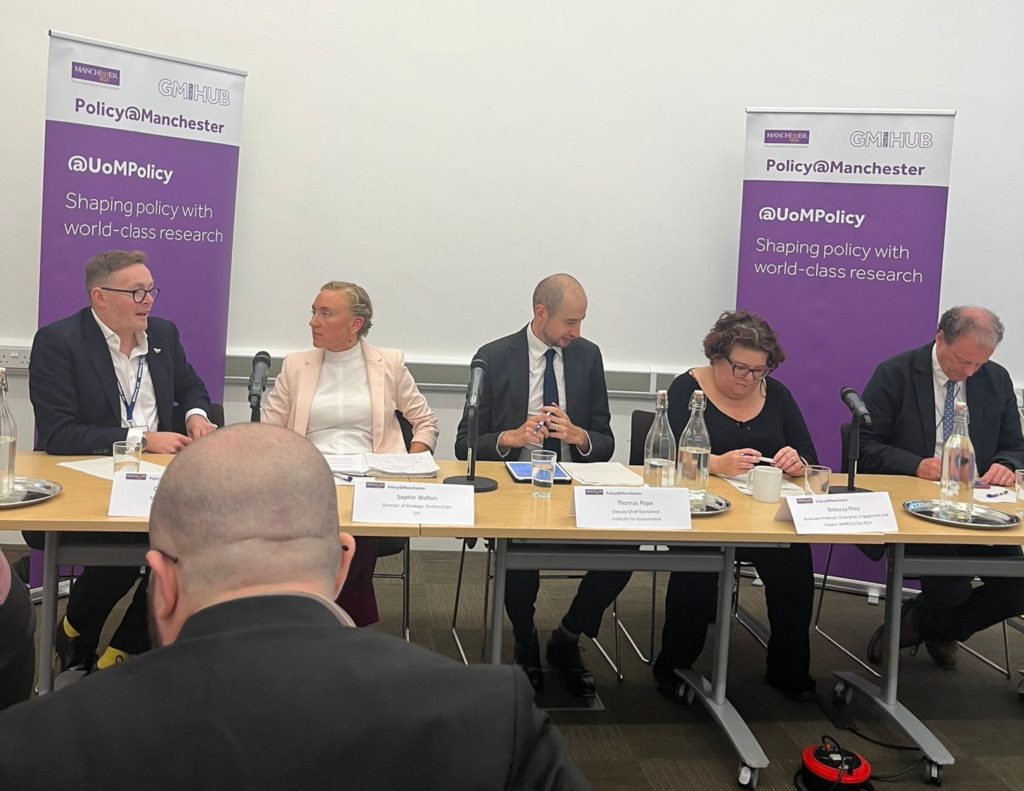
On 2nd October, City-REDI / WMREDI, University of Birmingham and Policy @ Manchester co-hosted a fringe event at the Conservative Party Conference on how to accelerate placed-based growth and innovation. Steve Barwick and Fumi Kitagawa reflect on the lessons learnt at the event held in Manchester.
The event was chaired by Thomas Pope, Deputy Chief Economist, Institute of Government and the panel featured:
- Chris Clarkson MP & Member of the Science, Innovation and Technology Committee
- Professor Richard Jones, Vice-President for Regional Innovation and Civic Engagement, University of Manchester, and Independent Science Advisor, Innovation GM
- Rebecca Riley, Associate Professor for Enterprise, Engagement, and Impact, City-REDI / WMREDI, University of Birmingham
- Sophie Walton, Director, CPI

Sharing the experiences of the Innovation Accelerator Pilots (IAPs)
To accelerate innovation and deliver greater place-based, inclusive growth, future policy must encompass an innovation strategy embedded in places by bringing together business support, skills development and investment.
The aim of the fringe meeting was therefore to share the experiences of the three Innovation Accelerator Pilots (IAPs), particularly from Greater Manchester and West Midlands, and draw lessons for future policy regarding innovation and place-based growth.
Discussion included:
- How have the Innovation Accelerator Pilots risen to the challenge of delivering inclusive and place-based innovation?
- What are the roles of universities in helping accelerate innovation which translates into place-based inclusive economic growth?
- What are the implications for places beyond the Innovation Accelerator Pilots?
Create a connected ecosystem at the local level
Each of the Innovation Accelerator Pilots took different approaches based on the local governance structure. Each IAP found positive approaches to fund and organise innovation investment which benefits each place, enabling a positive change in the relationship between the local and central government.
The IAPs highlighted the critical importance of partnerships between different parts of the regional ecosystem. Key stakeholders in a region like universities, catapults, development agencies, and the NHS need to be aligned. Triple or Quadruple Helix partnerships are important.
Universities as anchor institutions
Universities have an important role as anchor institutes in regions. Universities can – and do – help put actors together by providing business support, particularly R&D and skills, and providing an evidence base.
At the same time, it is imperative that universities keep “blue sky” scientific research capabilities ensuring long-term solutions while improving applied commercialisation capabilities.

The balance between the excellence model and inclusive growth
There is a need to understand the diversity, geography and supply chain linkages within each city region.
It is important to create a virtuous cycle of agglomeration benefits – ultimately innovation should be improving skills and productivity. There is a need to connect opportunities with the diverse needs of communities, recognising different career pathways and entry points.
Help adoption and diffusion of innovation to businesses, particularly Small and Medium-sized enterprises (SMEs)
SMEs are very important for the innovation economy but can be overlooked. It is important to spot innovative SMEs, particularly those with disruptive innovation capabilities, and provide intensive and continued support.
Innovation Accelerators should be outcome focused and there is a need to understand the specific business and sectoral needs through business leadership voices.
Implications for places beyond IAPs, including places without Combined Authorities.
It is important to recognise what already exists build on regional strengths, and invest in people and social structures.
Getting the right structure – new governance structures – will be imperative to create place-based innovation opportunities beyond the three pilots. We should be also aware that it would take a longer time for some places to build appropriate structures and data/evidence.
Lessons and room for improvement
What have we learned from the IAPs?
There needs to be flexibility in funding routes enabling the alignment of innovation funding with wider funding pots (e.g., inclusion as well as net zero).
Competitive funding models are not helpful. There is too much competition – i.e., competitive tendering and bidding. We need to promote collaboration at the local level to allow places to be globally competitive.
Funding also needs to be provided for longer periods of time. The timeline of the IAPs is three years: continuity at the local level with a longer-term view is required to achieve impacts from the place-based innovation strategies.
Putting innovation at the heart of the economy is money well spent. Devolving R&D capacity is also critical – lessons can be learnt from different models i.e., from international comparisons as well as IAPs.
Other Combined Authorities – Liverpool City Region, South Yorkshire, West Yorkshire – could provide structure to allow the devolution of innovation funding to more city regions.
We should be aware of the scale of the “missing billions” of the R&D public spending gap between London/South East and the rest.
Read a blog from our Labour Party fringe event.
This blog was written by Professor Fumi Kitagawa, Chair in Regional Economic Development, City-REDI / WMREDI, University of Birmingham and Steve Barwick, Political Consultant.
Disclaimer:
The views expressed in this analysis post are those of the authors and not necessarily those of City-REDI or the University of Birmingham.
